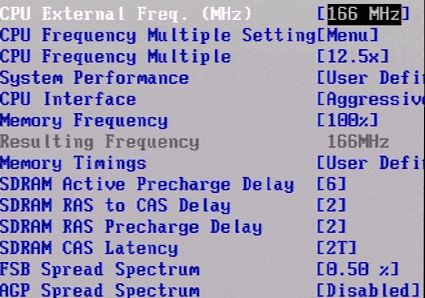Barton's Here: Athlon XP 3000+ vs. P4 3.06 GHz
Overclocking To 2500 MHz - How It Works, Continued
What is interesting about this is obseving how well the Barton Athlon scales at higher clock speeds - with a constant FSB speed of 166 MHz.

A look at the Asus A7N8X BIOS: the translation table is activated so that the higher multipliers are free.

Important in overclocking: the front side bus should always work in 166 MHz, while the memory should run (asynchronously) at 200 MHz (DDR400). Although synchronous operation would have added speed, stable operation could not be achieved.
The Athlon XP 3000+ is factory-set for the adjustment of 13 x 166 MHz. An important precondition for overclocking the Athlon XP is a suitable motherboard and BIOS. In our case, we used the Asus A7N8X with the 1002 BIOS 004 beta version.
By way of explanation: because of the 4 bit address, the board can transmit a multiplier between 5.0 and 12.5 (16 individual values) to the CPU. But if a multiplier of 13 (as in the case of the XP 3000+) or higher is generated, the CPU will work with an internal translation table that interprets the 5.0 multiplier as 13. Therefore, only values from 13.0 onward can be set. But to get the performance of the lower-clocked Athlon CPUs, the translation table in the CPU must be disabled.
The result is that multipliers between 5.0 and 12.5 are once again available. This setting is especially interesting if an FSB speed of 200 MHz is going to be used together with dual DDR400.
The Athlon XP 3000+, for example, can therefore be clocked at 11 x 200 MHz = 2200 MHz, although in the various test setups, stable operation was not possible. Thus an FSB speed with 200 MHz in the Athlon XP is, for now, just a dream. And, at the moment there is no specified platform - neither from NVIDIA nor from VIA - that provides perfect and, above all, synchronous 200 MHz FSB and memory speed.
Stay on the Cutting Edge
Join the experts who read Tom's Hardware for the inside track on enthusiast PC tech news — and have for over 25 years. We'll send breaking news and in-depth reviews of CPUs, GPUs, AI, maker hardware and more straight to your inbox.
Current page: Overclocking To 2500 MHz - How It Works, Continued
Prev Page An End User's Question: How Many L2 Caches Does The Athlon Have? Next Page Overclocking To 2500 MHz - How It Works, ContinuedMost Popular

